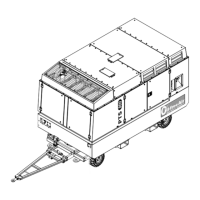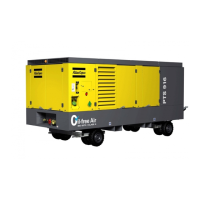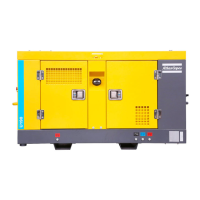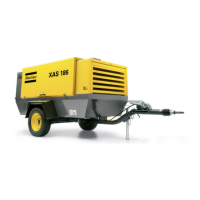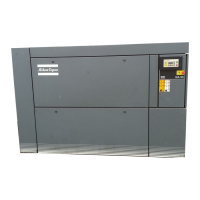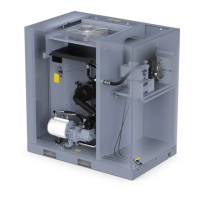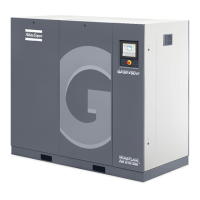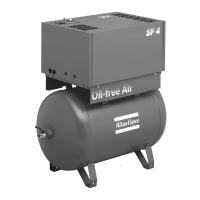- 38 -
When less air is needed, the pressure rises and the PID
will decrease the engine RPM.
When the engine RPM is at its minimum, and the air
flow needed is still smaller than the compressor’s
output, the pressure will rise until it reaches the
Unload pressure. Then the PID will become inactive
and the loading valve will close. The engine runs at
RPM Min. (unload condition).
When the air discharge pressure drops again, below
the Reload pressure, the loading valve is opened and
the PID becomes active.
5.3.3.7 Cooling down
When the Stop button is pressed, the engine runs idle
for a specified time. If the engine already ran
unloaded for some time, before pressing the Stop
button, this time is substracted from the cooldown
time because the engine conditions in these cases are
the same. This is also why the engine stops without
cooldown in automatic stop operation.
When a unit goes to cooldown due to "Engine coolant
temperature too high" (see “Engine warnings”). The
unit will shut down and on the screen appears "ready
for start". When pressing the start button "start
request denied" will be displayed. After resetting, this
message is cleared and a start attempt can be made.
Cooldown Time: default 3 minutes.
5.3.3.8 Shutdowns
There are several parameters which are continuously
watched. When one of these parameters exceeds the
specified limits, the compressor will shutdown
immediately.
The parameters appear on the screen.
The operator can leave the Shutdown status at any
time, and go to the Ready for Start status or to the
Process Info status by pressing the reset button.
Restarting before the parameter is back within its
limits is impossible, because of the parameter check
in the cranking procedure.
5.3.3.9 Emergency stop
When an emergency stop button is hit, this message
appears on the screen.
Until the emergency stop button is reset, the operator
cannot do anything.
When the emergency stop button is reset, the operator
can proceed to the Ready for Start status or to the
Process Info status.
5.3.3.10Unload RPM Control
It allows compensation of engine power at high
altitude applications.
In the Unload condition the engine will run at the
Unload RPM.
In the Load condition the engine will not run slower
than the Unload RPM. If the Unload RPM parameter
is enable, it is possible for the user to change the
Unload RPM with the UI.
5.3.3.11Loading Valve Control
When the compressor is going to the load condition,
and the engine RPM setpoint is above 1420 RPM the
loading valve is opened when the engine reaches
1400 RPM.
If the engine RPM setpoint is below 1400 RPM, the
loading valve is opened at the engine RPM setpoint -
20 RPM.
5.3.3.12Pressure Calibration
To compensate the offset error of the Air Discharge
Pressure sensor, a Pressure Calibration parameter is
implemented.
The offset error is measured by comparing the sensor
value with that of a verified and stamped pressure
gauge.
This parameter is programmed with the value that
compensates the error.
Ex. Pressure gauge value: 7.8 bar
Sensor value: 8.1 bar
Parameter value: - 0.3 bar

